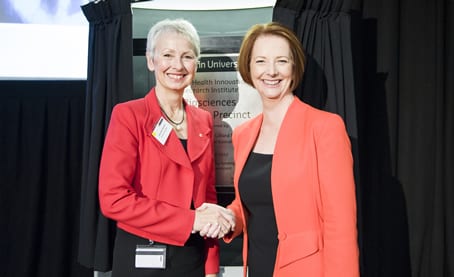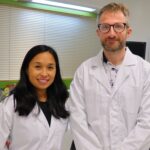Prime Minister Julia Gillard opened the Curtin Health Innovation Research Institute (CHIRI) Biosciences Research Precinct on Wednesday 5 September.
[Youtube width=”560″ height=”330″]http://www.Youtube.com/watch?v=fH4XihInf1w[/youtube]
The $35 million facility will help drive the search for new and improved methods of diagnosis and the discovery of medicines key to fighting chronic diseases afflicting people worldwide.
Particular focus areas include diabetes, tissue engineering, cancer, stem cell and pharmaceutical research.
The Precinct unites leading researchers across biomedical sciences, pharmacy and public health all in one central location creating a vibrant, multidisciplinary research and teaching community.
Supported by a $13.7 million Federal Government grant through the Better Universities Renewal Fund, the two-year building refurbishment project has seen the transformation of one of the university’s original 1960s buildings into an exciting hub of ground-breaking research and interprofessional learning.
Professor Hacket said Curtin was extremely grateful to the Federal Government for their support that had allowed the vision for the CHIRI Biosciences Research Precinct to become a reality.
“The CHIRI Biosciences Research Precinct will allow the expansion of partnerships with industry and research institutions worldwide, with a view to developing solutions to health problems that affect Australians and people around the world,” Professor Hacket said.

“The mix of laboratory-based research, simulated consulting rooms and quality teaching facilities enable students and researchers to experience the entire process of ‘benchtop to bedside’ in a single facility.”
Curtin was the first University in Australia to offer an interprofessional approach to its curriculum across its 24 health science degree specialities. The Precinct embraces this concept with its teaching facilities being used by a range of health science students.
The ground floor ‘Model Pharmacy’ practice teaching space is a unique feature to a Western Australian university. Students will gain ‘real to life’ pharmacy experience in a simulated consulting and dispensing environment, which includes a state-of-the-art robotic dispensing system.
The first floor consulting rooms will used by nursing and public health students to offer staff and student health checks, and to seek participants for research studies.
The second floor has 24 specialist instrumentation suites and lab space for 100 researchers and postgraduate research students.
The instrumentation suites will be home to more than $2 million worth of advanced instrumentation equipment. This includes a microscopy suite containing a state-of-the-art live cell confocal microscope capable of high resolution imaging of a variety of cells responsible for chronic diseases.
“Many of the pieces of equipment are new to Western Australia. This will enable new research capabilities to WA-based researchers and open up new opportunities for collaboration across the world,” Professor Hacket said.
“This new facility will clearly build on Curtin’s reputation of excellence in biomedical and pharmaceutical research.”
“It will open up exciting new prospects of discovery and expansion of research activities globally with the aim of delivering practical new health solutions and to improve the health of our community,” Professor Hacket said.
Notes to editor
• The $13.7 million grant from the Better Universities Renewal Fund was announced in April 2009 by Prime Minister Julia Gillard in her previous role of Federal Education Minister.
• A sustainable approach was taken to this building project, the biggest factor being to keep the skeleton of the original building rather than demolishing. This reduced overall cost and resource use substantially.
• Eco-friendly design elements of the building include rainwater harvesting and energy efficient air conditioning and lighting systems.
Media Contact:
Denise Cahill, Public Relations, Curtin University
Tel: 08 9266 1931, Mobile: 0401 103 683, Email: d.cahill@curtin.edu.au
Kristy Jones, Public Relations, Curtin University
Tel: 08 9266 9085, Mobile: 0401 103 877, Email: k.jones@curtin.edu.au



